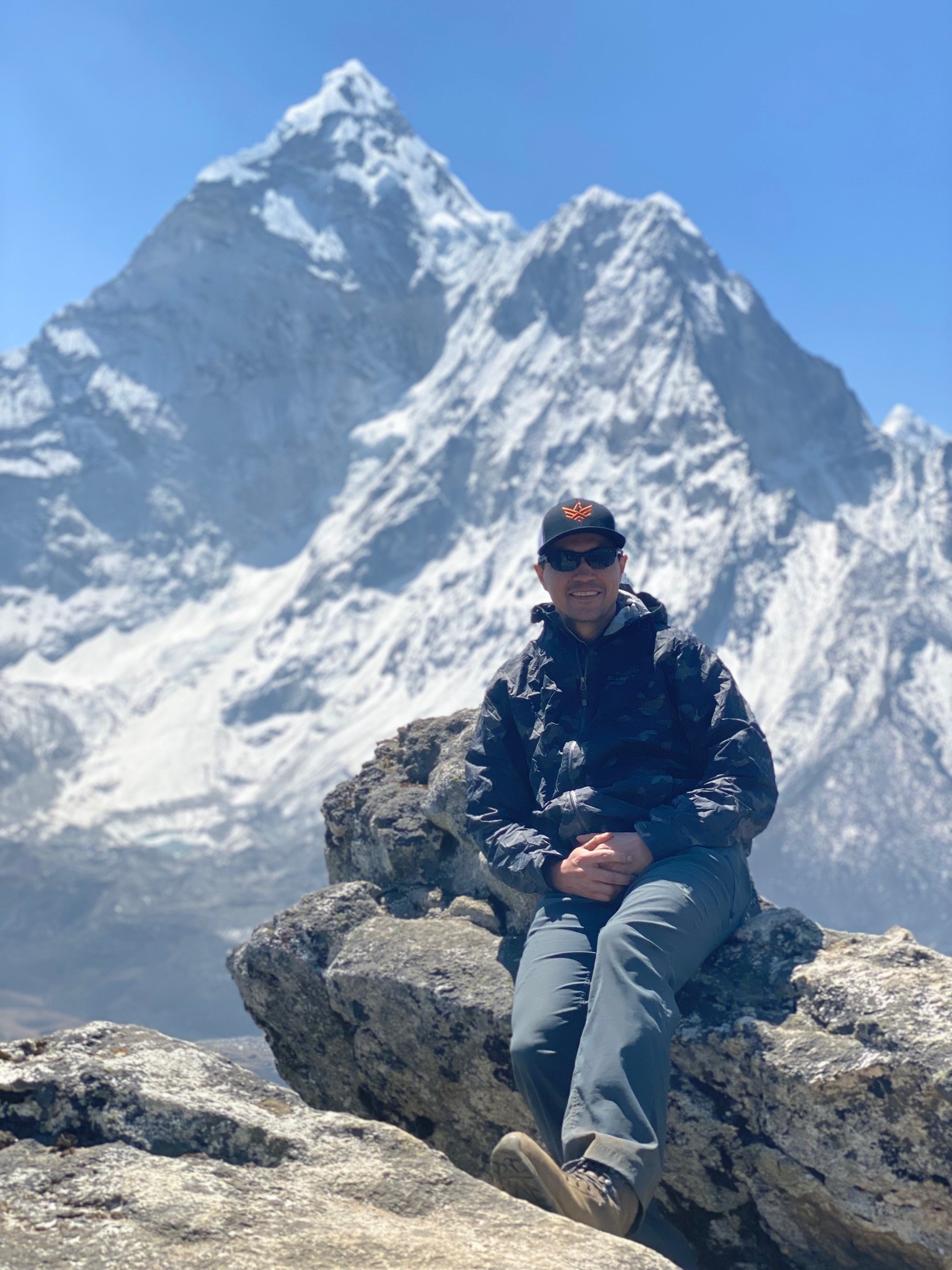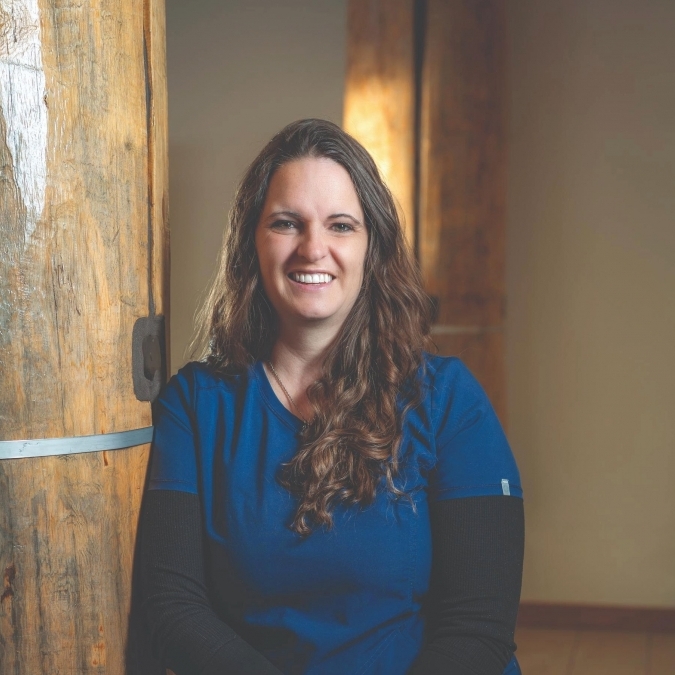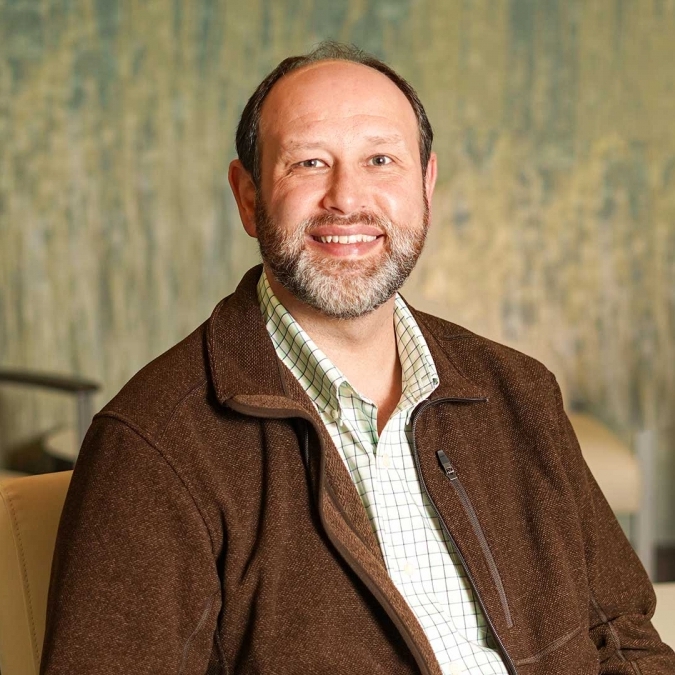At almost 22,000 feet of elevation, climbers on Mount Everest ascend Lhotse Face toward Camp III. What starts as a flat walk leads to an icy incline, where climbers will clip into fixed lines — ropes that are permanently in place to facilitate climbing — in order to ascend what is essentially a 4,000 foot icy slide. Ice and rock, dislodged by climbers moving above, careen downward.
As Trauma Surgeon Jacob Weasel, M.D., approached the Lhotse Face, one of those rocks, roughly the size of a billiard ball, hit him on the left side of the chest. His experience and medical knowledge told him that while the impact hadn’t broken any ribs, it had caused severe bruising. But there’s only one thing to do on Mount Everest — just keep going.
“In the aftermath, after I’ve come back down from the mountain, I know how crazy that is,” said Dr. Weasel. “A foot higher and four inches to the right, it impacts my heart and I’m dead. If it had hit me in the throat or face, I wouldn’t have come off the mountain alive. Instead, I just continued on to Camp III.”
It’s a long way to the top
Everyone knows that it’s a challenge to climb Mount Everest, but they may not grasp just how complicated it can be. It’s a multistage process that can take up to two months. The first step is getting to Everest Basecamp — a one- to two-week journey in and of itself. From there, it takes an average of 40 days to reach the summit of the tallest mountain in the world.
The route up Mount Everest, for those braving the climb, is broken up into four camps, not counting Basecamp. A process of ascending, acclimatizing to the thinner air, descending and then climbing again is the only way to prepare for the final push to the summit from Camp IV. Finally, if weather and timing cooperate, climbers can make a bid for the summit, which can take anywhere from eight to 16 hours.
Dr. Weasel departed Rapid City on April 10, and summited Everest on May 17, 2023 — close to the average time to complete the feat.
You may have seen photos of lines of people leading up Everest. These may make it look like immeasurable amounts of people have reached the summit, but if you were to amass a group of everyone who had been to the top of Mount Everest, you’d have a relatively small club. By the end of the 2023 climbing season, the total number of climbers who have summited since Edmund Hilary and Tenzing Norgay became the first confirmed summiters in 1953, sits at around 7,000. To put that in perspective, that is less than one tenth of one percent of the current world population.
“This is an opportunity that few people get,” said Dr. Weasel. “I’m grateful for it.”
Dr. Weasel has developed a solid resume of mountain climbing before summiting Mount Everest (29,032 ft). His first experience mountaineering was climbing Mount Rainier (14,411 ft) when he finished his undergraduate degree. Since then he has tackled 14ers — mountains reaching 14,000 feet above sea level — in Colorado, as well as Cloud Peak (13,171 ft) and Grand Teton (13,775 ft) in Wyoming. He traveled to Ecuador to climb Cotopaxi (19,347 ft) and Chimborazo (20,549 ft) and to Tanzania to summit Kilimanjaro (19,341 ft).
Why Mount Everest
There are a lot of reasons why people climb Mount Everest. Some need the biggest challenge they can find, others are seeking thrills. For some, the mountain is laden with meaning and significance. Dr. Weasel loves climbing mountains, but Mount Everest was never on his metaphorical horizon. That is, until he realized how he could use the mountain to do good.
“It’s important to me to give back. That’s why I took a position serving as an Assistant Dean for Diversity and Inclusion at the University of South Dakota Sanford School of Medicine,” Dr. Weasel explained. “One of my goals is to try and recruit and encourage native kids to pursue careers in health care and related fields.”
The Everest trek provided the physician with additional avenues for helping others. He hoped he could set an example for native youth, to show them that they are equally as capable as anyone. “Whether we’re talking academics, the professional world or yes, climbing Mount Everest, I want all native people to know that they’re capable of accomplishing anything.”
Leading up to his departure for Nepal, Dr. Weasel created a nonprofit called the Wopila Project. Wopila is a Lakota expression of gratitude for everything that life offers, for existence and for the blessings in every moment. “The goal is to cultivate gratitude, to inspire hope and to work together to create a tangible impact in people’s lives,” he said. “My hope was that I could use my Everest climb to raise awareness of our current projects and get people involved. I’m happy to say that there has been positive feedback, and I’m excited to keep the momentum going.”
Dr. Weasel’s nonprofit, the Wopila Project, is currently raising funds to build a playground at Lakota Homes, a housing community in Rapid City that serves the local Native American population. The plan includes surrounding the playground with informational displays of each of the seven traditional Lakota values; Prayer, Respect, Wisdom, Compassion, Honesty, Generosity and Humility. Once completed, the next goal is to construct sustainable women’s health clinics in Nepal in order to provide obstetric and gynecological care to help the disparity related to women’s health in the rural areas of the country. To learn more about the Wopila Project, visit www.wopilaproject.com.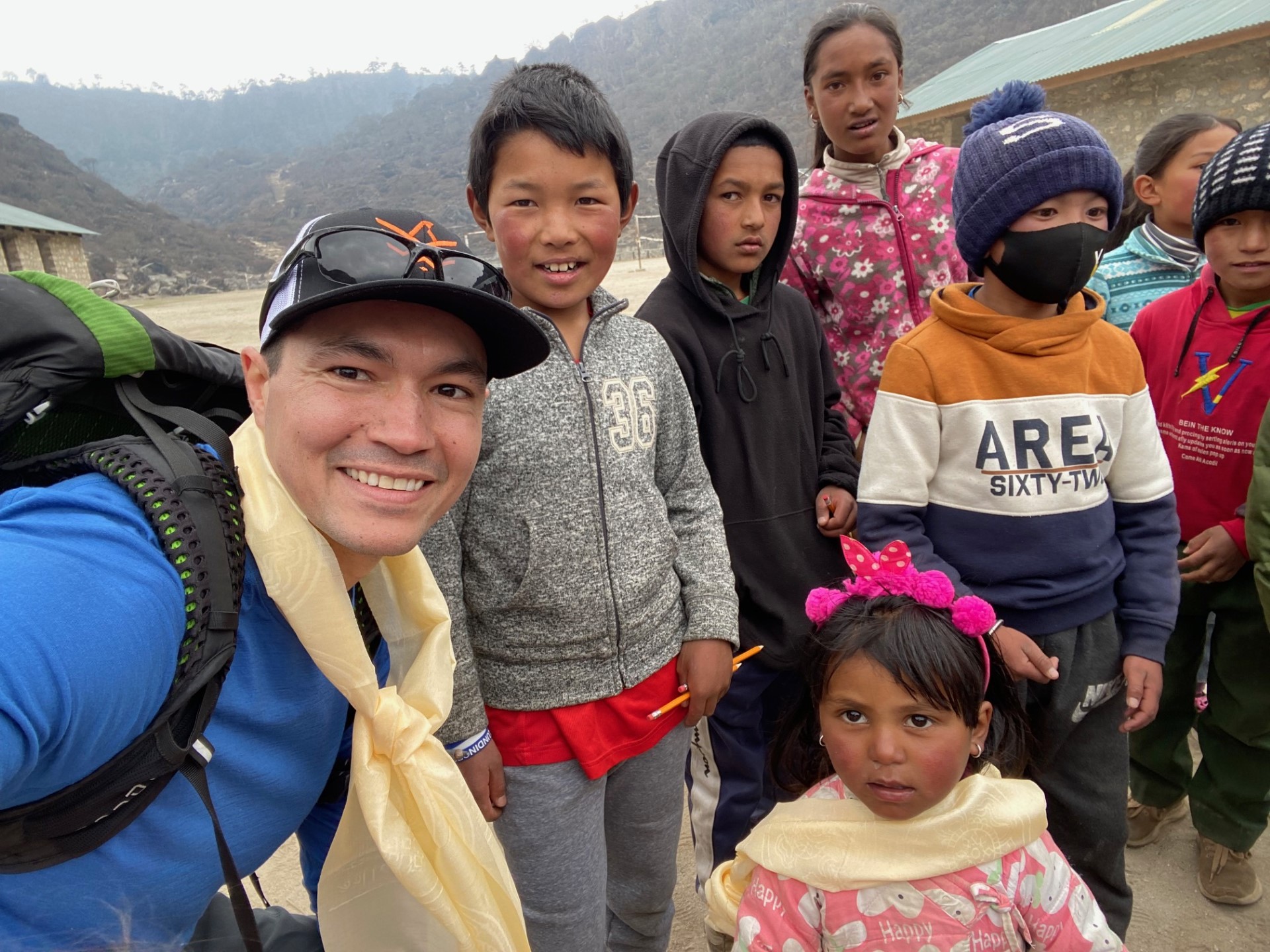
A view from the heavens
After arriving at Camp IV, Dr. Weasel and his Sherpa, Lhakpa, took a rest day. They ate and hydrated, and tried to rest and sleep as best they could. They stepped out of their tent at 10 p.m. the next night, to perfect conditions — clear skies with no wind.
Despite the evening start, there was already a line of people, but Dr. Weasel and Lhakpa passed climbers and pressed onward. “The mountain just keeps going. It goes on and on and on. It never seems to end and you just keep climbing,” said Dr. Weasel. “And I kept occasionally looking at my watch, asking myself, ‘when is the sun going to rise?’ Because I was freezing cold, and wanted nothing more than to see the sun rise.”
In May, the average temperature at that elevation is -13 Fahrenheit. It can get much colder, and wind chill can lower that temperature significantly. Luckily the air was pretty still for Dr. Weasel. While the rising sun wouldn’t raise the temperature significantly, every degree counts on Mount Everest, and the psychological benefit of sunrise would have a dramatic effect.
Dr. Weasel explained, “You just keep. climbing and then you get to the point where the sun finally starts to peek out. And it is breathtaking. That was probably the most beautiful thing I've ever seen in my life. It is amazing watching the sun rise over one part of the valley and then look to the other side and seeing the perfect pyramid of Everest’s shadow being thrown onto the valley. And you cry because it is that beautiful. Then your tears freeze to your face, but it is literally amazing.”
You might expect a similar sense of awe at the summit, but for Dr. Weasel, the experience was somewhat muted. He said that the view was incredible — from the top you can see 200 miles of the world spreading out beneath you. Across the valley to the northwest is Cho Oyu, which is the eighth-tallest mountain in the world. Looking Southeast you’ll see Makalu, the fifth-highest, and closer still is Lhotse, the fourth-tallest.
That last view, of Lhotse, is partially responsible for Dr. Weasel’s more muted response to the summit of Everest.
“The summit was good, but I was there to climb two mountains,” Dr. Weasel said, explaining his plans to climb Lhotse following his completion of Everest. “When I stood on the summit of Everest, I didn't fully appreciate it because I was so disciplined at that point that in my mind, I was only 25 percent done.” Mentally, he was already working on the descent back to Camp IV, from which — if things went according to plan — he and Lhakpa would then summit Lhotse the next day before beginning the trek back to basecamp.
Unfortunately, a number of considerations conspired against the two men, and in the end the second climb didn’t happen. One of the reasons likely being the amount of time Dr. Weasel had spent in what is known as the Death Zone.
The Death Zone
As a general rule, human bodies work most efficiently and effectively at sea level. At high altitudes, bodies become less and less efficient. For those that want to summit Mount Everest, they have to enter — and stay in — what is known as the “Death Zone.” At this elevation, above 8,000 meters or 26,247 feet, the air has so little oxygen that the human body will begin slowly dying, one cell at a time, even when using supplemental oxygen.
“Making it to the top is everyone’s goal, but once you do you’re not done. You still have to descend safely,” said Dr. Weasel. And while it may seem like it should be easier to come down from the world’s highest peak than it was to go up, more accidents occur during the descent. A combination of exhaustion, hypoxia, a caloric deficit and hypothermia — combined with the inherent risks of avalanches, falls and other injuries — make coming down a challenge unto itself.
As climbers’ brains starve for oxygen, their judgment and decision-making skills get progressively worse. As the lungs struggle with oxygen deprivation, the risk of heart attack and stroke increase, as does the likelihood of a high altitude pulmonary edema. This happens as the body produces additional hemoglobin in an attempt to compensate for the lack of oxygen. As it thickens the blood, it can also cause an accumulation of fluid in the lungs that comes with shortness of breath, a sense of impending suffocation and persistent coughing.
Likewise, if the brain doesn’t get enough oxygen, it can cause swelling which leads to high altitude cerebral edema. Symptoms include nausea, vomiting, impaired judgment and difficulty thinking. At worst, it can lead to delirium in which climbers may not remember where they are, begin destroying clothing and gear or speaking to people who aren’t there.
Most climbers are advised to not remain in the Death Zone longer than 24-48 hours. Dr. Weasel estimates that he spent about 63 hours, between his arrival at Camp IV, summit and descent.
“I recognize that with that much time in the Death Zone, at any point my body could have just said, ‘no,’ and given up,” he said. “I could have just collapsed and died.”
Although he returned safely, that doesn’t mean that the Death Zone didn’t take a toll on the physician. “I definitely hallucinated on the way up and on the way down. I heard voices of my team members on the way up,” he said. “On the way up, and even more pronounced on the way down, I saw the faces of my children, when they were younger, and the face of my wife coming out of the rock.”
Hallucination is a common, and temporary, symptom of hypoxia. It’s something that most climbers will have to endure on Everest, and after descending into a more oxygen-rich altitude, the symptom goes away.
“I didn't consider the actual physiological effects of what was happening. I knew I was hallucinating, and just thought, ‘Hmm, that's interesting.’ And I just keep working my way down the mountain.”
“I have always found there to be a lot of similarities between surgery and mountaineering. In both cases you have a plan, but your plan never goes exactly as you anticipate, so you have to be agile and flexible enough to recognize and adapt to the situation as it's presented to you. There’s always a balance of risk and reward —you're trying to minimize the amount of risk and to provide the best possible outcome. Sometimes when you're on the mountain you’re dealing with life or death decisions. Those are high stakes, and they are similarly high during a surgery.”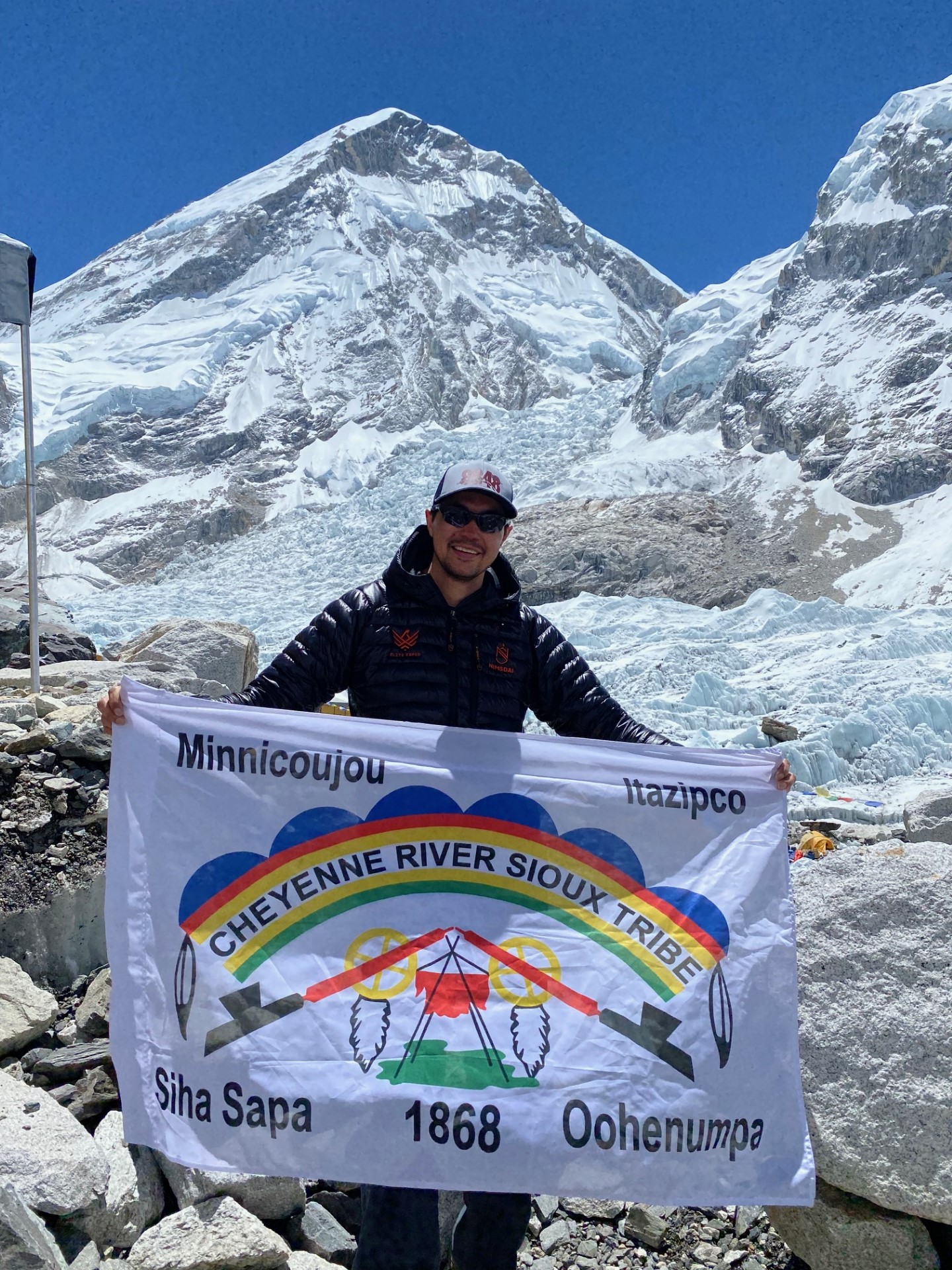
The man on the mountain
It may seem odd that someone who had just summited the tallest mountain in the world would feel disappointed, even angry, that he was turned back from the fourth-tallest. Especially after experiencing hallucinations in something called the Death Zone. But Dr. Weasel has a self-described stubborn streak. While that streak leads to disappointment when he’s turned back from a goal, it’s the same quality that empowers him to climb mountains — and to reach where he is in life now.
Dr. Weasel, an enrolled member of the Cheyenne River Sioux Tribe, knew from a young age that he wanted to become a surgeon. “When I told people that I planned to become a surgeon some people told me that there’s no way that that’s ever going to happen, that it’s not even possible,” he shared. “But the more that people would tell me that something wasn’t possible, the more that it spurred me towards accomplishing a certain thing.”
That stubborn streak would propel him up mountains like Cotopaxi and Chimborazo, where he experienced conditions he described as horrendous, including white out visibility and 50 mile-per-hour winds that pelted his face with ice which he likened to being in a sandblaster. Even before that, it spurred him on through his undergraduate education, medical school and surgical residency, an experience he likened to training for mountains.
“Surgical residency was super helpful for mountaineering. It was probably the best training that I could have had, learning how to operate with little sleep, learning how to operate mentally and physically on very little food and just taking a beating and having to come back and keep going,” he explained. “When you’re working 80 hours a week in residency and you still have a family, and you still have to read and prepare and do all those things — having experienced that kind of mental exhaustion on a long-term basis is super helpful when you’re on a mountain.”
There’s always another mountain
After climbing the tallest mountain on earth, you might think Dr. Weasel would hang up the mountaineering goggles and retire his crampons, but that isn’t the case. He said, “I love mountains, and so climbing them will be a part of my life for as long as I’m able.” He’s already working on his next great challenge — becoming the first enrolled member of a Native American tribe to reach the top of the Seven Summits. This entails climbing the highest mountains on each of the seven continents: Mount Everest, Aconcagua, Denali, Kilimanjaro, Elbrus, Mount Vinson and Puncak Jaya.
He’s already checked Mount Everest and Kilimanjaro off the list, and is looking forward to returning to Mount Denali in Alaska, the highest peak in North America, with a summit elevation of 20,310 feet above sea level — he almost summited in 2022 before his guide turned him around due to dangerous weather.
“I might as well save Mount Vinson in Antarctica for last, and then ski to the South Pole,” he said with a smile. “Because then, if I do that, I’d have to do the North Pole, making it an Explorer’s Grand Slam.”
Less than 100 people have completed this assemblage of summits and treks, and it’s easy to think of the challenges and adversity and ask, “Why?”
Maybe, as George Mallory said of climbing Mount Everest, “Because it’s there.”
Or perhaps, as Dr. Weasel said, “There’s an opportunity to inspire and help others while doing something that I love. That’s gratitude coming full circle.”
Written by Wade Ellett

